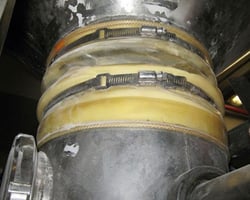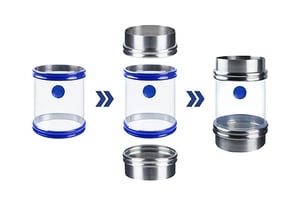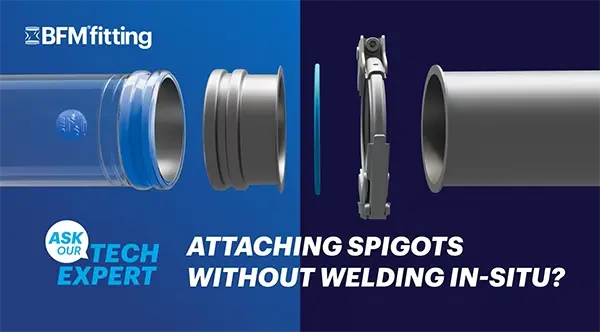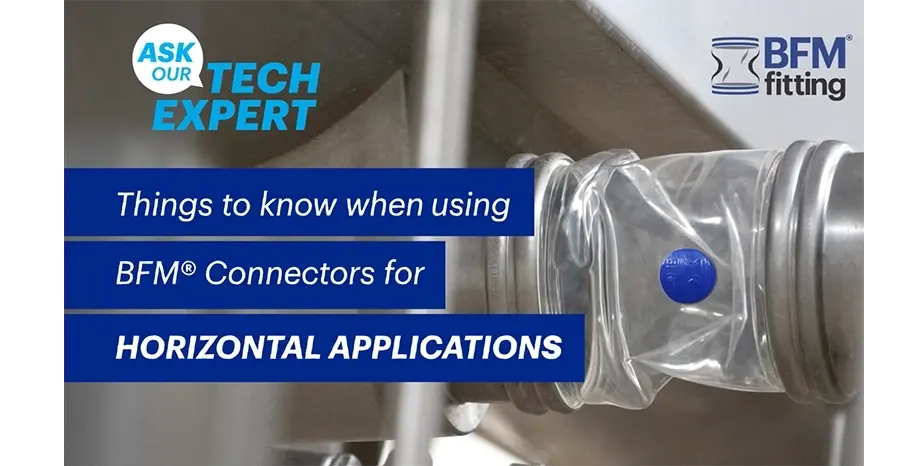There’s a reason so many manufacturers have moved away from hose clamps and jubilee clips for connecting pipes. While these traditional solutions may still be OK for domestic applications, like securing a dishwasher drainage pipe, they have significant limitations in large-scale bulk powder processing. Here are five reasons why it’s time to ditch the hose clamps once and for all:
- Leaks and Dust Escape
 Hose clamps often fail to provide a consistent, uniform seal around flexible connectors. Over time, factors like vibration, pressure fluctuations, and material wear can create gaps, resulting in product leakage and hazardous dust emissions.
Hose clamps often fail to provide a consistent, uniform seal around flexible connectors. Over time, factors like vibration, pressure fluctuations, and material wear can create gaps, resulting in product leakage and hazardous dust emissions.
This leads to product loss and poses significant health and safety risks, especially in environments like food production or pharmaceutical manufacturing, where product purity is critical.
Dust emissions can contribute to poor air quality in the workplace, increasing the potential for respiratory issues among staff and raising the risk of combustible dust explosions.
- Frequent Maintenance and Downtime
Clamps need regular tightening due to vibration, especially in high-movement applications like sifters and conveyors. Product leaks caused by loose clamps require frequent clean-ups, which leads to more downtime and higher operational costs. This constant need for maintenance adds to labour costs and diverts resources away from other essential tasks.
If product run changes and cleaning processes are frequent, the labour time to remove hose clamps and replace and correctly adjust the connector position and length for every location can be considerable, adding to production downtime.
- Hygiene and Cleaning Challenges
 Clamps fasten sleeves externally, leaving crevices where powder can accumulate. In industries like food and pharmaceuticals, this increases contamination risks and complicates cleaning processes.
Clamps fasten sleeves externally, leaving crevices where powder can accumulate. In industries like food and pharmaceuticals, this increases contamination risks and complicates cleaning processes.
Even with rigorous cleaning protocols, residues can persist in these hard-to-reach areas, increasing the likelihood of cross-contamination between production runs. This poses a major compliance risk, as regulatory bodies like the FDA and HACCP demand stringent hygiene standards to ensure product safety. The additional cleaning time required also reduces overall production efficiency.
- Safety Hazards
Operators handling clamps are at risk of cuts, bruises, and other hand injuries, particularly when clamps corrode or when tools slip during tightening. Manual tightening of hose clamps during maintenance can also cause pinch-point injuries. Loose or broken clamps also risk product contamination and pose safety hazards.
-
 Inconsistent Fit and Performance
Inconsistent Fit and Performance
Achieving a uniform seal with a hose clamp requires manual adjustments that often result in uneven pressure, connector damage, and premature wear. Inconsistent installations can also disrupt product flow.
The variability of manual fitting means that different operators may apply different torque levels, resulting in varying seal integrity across production runs. The position and length of the connector are also dependent on the installation method, can vary by operator, and can cause many operational inefficiencies.
The Modern Alternative: BFM® fitting

Forward-thinking companies are replacing hose clamps with BFM® fittings to improve efficiency, reduce maintenance costs, and enhance system reliability.
The BLUEBAND™ flexible connector system eliminates clamps entirely by using precision-formed steel spigot adaptors and a flexible connector with tensioned cuffs. This innovative design ensures that connectors are installed correctly every time, providing a consistent and reliable seal that reduces product loss and contamination.
Internal Snap-In System for a Perfect Fit
 BFM® fittings seal from the inside using a snap-in, tensioned system that ensures a correct fit every time, regardless of who installs it. This design accommodates movement and vibration, making it ideal for sifters and shakers.
BFM® fittings seal from the inside using a snap-in, tensioned system that ensures a correct fit every time, regardless of who installs it. This design accommodates movement and vibration, making it ideal for sifters and shakers.
The hygienic, crevice-free fit also simplifies cleaning and meets stringent global food and pharmaceutical compliance standards. The internal seal creates a uniform connection that withstands pressure variations without leaking, improving process consistency and reducing the need for maintenance.
Additionally, the BFM® system's simplicity speeds up maintenance tasks. With no external clamps to adjust or replace, operators can remove and replace connectors in seconds, significantly reducing downtime.
The standardized design also minimizes the need to stock multiple connector sizes, streamlining inventory management.
Proven Performance Across Industries
The snap-fit design outperforms hose clamps in numerous real-world applications. Here are two examples that demonstrate the effectiveness of the BFM® fitting system:
- AkzoNobel (Netherlands)
 At AkzoNobel’s Elotex plant, fine, abrasive powders leaked through hose-clamped connectors, creating a significant explosion risk. Even minor tears or misalignments allowed dust to escape into the plant environment.
At AkzoNobel’s Elotex plant, fine, abrasive powders leaked through hose-clamped connectors, creating a significant explosion risk. Even minor tears or misalignments allowed dust to escape into the plant environment.
After testing BFM® fittings in their most problematic sifter location, the results were so successful that all 25 connectors were replaced. The plant now operates without dust leaks, improving safety and cleanliness. This upgrade has significantly reduced the risk of combustible dust events and improved the working environment for employees.
- Nestlé ESAR (East and Southern Africa Region)
 One of Nestlé ESAR’s South African plants faced persistent flour leakage from silicone connectors secured with hose clamps. The resulting dust accumulation posed a safety and contamination risk.
One of Nestlé ESAR’s South African plants faced persistent flour leakage from silicone connectors secured with hose clamps. The resulting dust accumulation posed a safety and contamination risk.
Fine flour dust compromised air quality and increased the likelihood of product recalls due to contamination.
After upgrading to BFM® fittings, the airtight connections eliminated leaks, improved plant hygiene, and significantly reduced explosion risks. Maintenance staff also reported that the new system made connector replacements more straightforward and faster, boosting productivity.
Future Proof Your Plant by Replacing Your Hose-Clamps
Hose clamps may have served their purpose for decades, but their limitations in modern bulk powder processing are undeniable. From inconsistent sealing and hygiene challenges to safety hazards and excessive maintenance requirements, these traditional fittings fall short of the performance standards demanded by today's industries.
Companies like AkzoNobel and Nestlé have already experienced the benefits of switching to BFM® fittings, improving hygiene, safety, and operational efficiency. The internal snap-fit design ensures reliable, consistent performance while simplifying maintenance and cleaning processes. I
If you want to future-proof your production line and enhance product integrity, you should retire hose clamps and upgrade to a more reliable, efficient solution.


